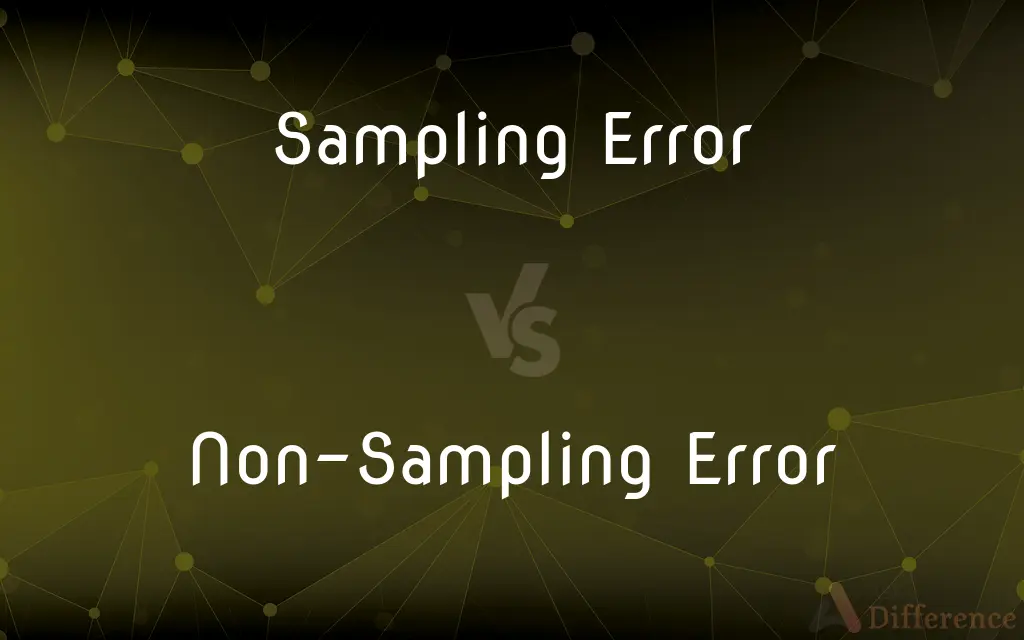Sampling Error vs. Non-Sampling Error — What's the Difference?
By Tayyaba Rehman — Published on December 25, 2023
Sampling error refers to the variation in data caused by using limited samples, while non-sampling error encompasses errors stemming from sources other than the sampling process.

Difference Between Sampling Error and Non-Sampling Error
Table of Contents
ADVERTISEMENT
Key Differences
Sampling Error is the deviation of a sample estimate from the true population parameter. This is caused by selecting a subset, or a sample, from a larger population. Non-Sampling Error, on the other hand, encompasses all the errors that aren't due to sampling. It could arise from various stages of the research process, including data collection, processing, and analysis.
Sampling Error can be reduced by increasing the sample size, as with a larger sample, the chances of the sample statistics representing the population parameters increase. Non-Sampling Error is trickier, as it isn't always about the sample size. This type of error could arise from factors like incorrect responses, data entry mistakes, or biases in the questionnaire design.
Sampling Error is generally associated with the random nature of sampling. It's inherent in the process of selecting a subset and is, to some extent, unavoidable. Non-Sampling Error is systematic and doesn't necessarily decrease with an increased sample size. This is because it is rooted in other parts of the research process.
Sampling Error gives an idea about the range within which the population parameter might lie, given the sample data. It is usually quantified through confidence intervals or margins of error. Non-Sampling Error is harder to quantify because it can stem from a variety of sources, both known and unknown.
While Sampling Error can be controlled and measured, making it predictable to a degree, Non-Sampling Error remains more unpredictable. Ensuring high-quality research practices can help in reducing both types, but while increasing sample size might help combat Sampling Error, it won't necessarily rectify Non-Sampling Errors.
ADVERTISEMENT
Comparison Chart
Origin
Arises due to sampling a subset.
Occurs due to factors other than sampling.
Nature
Random.
Systematic.
Reduction Technique
Increase the sample size.
Improve research design and data collection processes.
Quantifiability
Can be quantified (e.g., margin of error).
Harder to quantify.
Relation to Sample Size
Reduces with increased sample size.
Doesn't necessarily reduce with an increased sample size.
Compare with Definitions
Sampling Error
Discrepancy from sampling, not the entire population.
The report indicated a 2% Sampling Error in the findings.
Non-Sampling Error
Mistakes outside of sampling.
The questionnaire bias introduced a significant Non-Sampling Error.
Sampling Error
Deviation between sample and population.
The study showed a 5% Sampling Error.
Non-Sampling Error
Errors not from sample variability.
Data entry issues caused a notable Non-Sampling Error.
Sampling Error
Variation due to limited samples.
With a small sample, the Sampling Error was high.
Non-Sampling Error
Flaws not related to sample selection.
Due to a Non-Sampling Error, the results were skewed.
Sampling Error
Random fluctuations in sample estimates.
Sampling Error resulted in a 3% discrepancy in the results.
Non-Sampling Error
Systematic errors in research.
The researcher's bias led to a major Non-Sampling Error.
Sampling Error
Error inherent in using a subset.
Due to Sampling Error, the survey's results slightly deviated.
Non-Sampling Error
Errors other than sampling randomness.
The survey had both Sampling and Non-Sampling Errors, but the latter was from data processing.
Common Curiosities
What is Sampling Error?
Sampling Error is the deviation of a sample estimate from the actual population value due to selecting a subset of the population.
Is Sampling Error random or systematic?
Sampling Error is random in nature.
Will increasing sample size eliminate Non-Sampling Error?
No, increasing sample size doesn't necessarily rectify Non-Sampling Errors.
Which error is more predictable: Sampling Error or Non-Sampling Error?
Sampling Error is more predictable due to its random nature.
How is Non-Sampling Error different from Sampling Error?
Non-Sampling Error encompasses all errors not due to sampling, such as data collection, processing, and biases.
Can increasing sample size reduce Sampling Error?
Yes, increasing sample size can reduce Sampling Error.
Which error affects the validity of a study more: Sampling or Non-Sampling?
Both can impact validity, but Non-Sampling Errors can be more detrimental as they're systematic.
Are Non-Sampling Errors always avoidable?
Not always. While some can be avoided with better research practices, others might still persist.
Can we quantify Sampling Error?
Yes, it's often quantified through margins of error or confidence intervals.
Can a study have both Sampling and Non-Sampling Errors?
Yes, a study can have both types of errors present.
How can researchers minimize Sampling Error?
By increasing the sample size and using appropriate sampling methods.
Can Sampling Error be eliminated entirely?
No, but it can be minimized. As long as a sample is taken, there's always some level of Sampling Error.
Why is Non-Sampling Error hard to quantify?
It can stem from various known and unknown sources, making it harder to measure precisely.
What are common sources of Non-Sampling Error?
Incorrect responses, data entry mistakes, and biases in the questionnaire design.
Is Sampling Error always present in a sample?
Yes, as long as a subset of the population is selected, there's inherent Sampling Error.
Share Your Discovery

Previous Comparison
5’11 vs. 6’1
Next Comparison
Micro Environment vs. Macro EnvironmentAuthor Spotlight
Written by
Tayyaba RehmanTayyaba Rehman is a distinguished writer, currently serving as a primary contributor to askdifference.com. As a researcher in semantics and etymology, Tayyaba's passion for the complexity of languages and their distinctions has found a perfect home on the platform. Tayyaba delves into the intricacies of language, distinguishing between commonly confused words and phrases, thereby providing clarity for readers worldwide.
















































